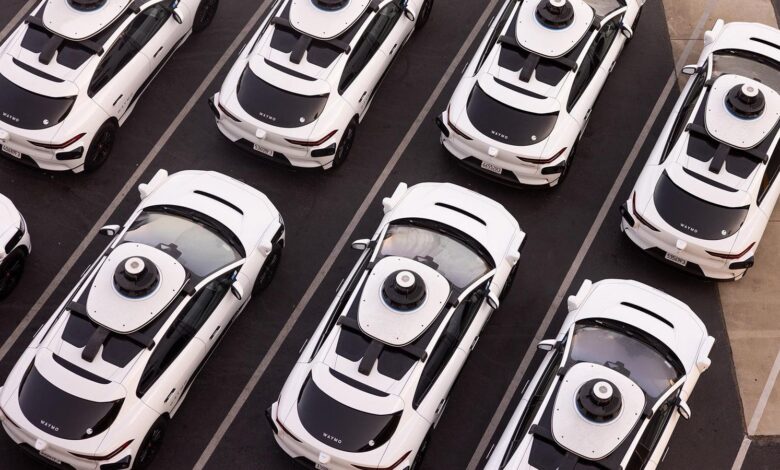Waymo’s Robotaxis Are Finally A Real Business For Google

Waymo robotaxis wait to go into action.
JasonDoiy/Getty Images
The Alphabet Inc. unit, which operates its commercial ride service in three major cities and is adding a fourth, is starting to generate significant revenue. But safety concerns persist.
By Alan Ohnsman, Forbes Staff
Every week, hundreds of Phoenix, San Francisco and Los Angeles residents find a cheerful message in their email inboxes: “Buckle up! You’re ready to ride. Welcome to Waymo One. Get ready for your first fully autonomous ride.”
With that confirmation, they’re off the waiting list for the largest U.S. robotaxi service – more than 500 electric Jaguar SUVs that can drive themselves. Waymo’s sensor-laden, AI-controlled fleet won’t be ubiquitous in U.S. cities any time soon, but 2024 is an inflection point for a technology that many advocates hoped would arrive years ago. After 15 years of R&D, more than $8 billion of investment and multiple pilot programs, Waymo’s robotaxis have become a business, booking more than 50,000 rides a week in the three cities. Assuming an average fare of $20 per ride, annual revenue should top $50 million this year. It was less than $1 million in 2022, according to a Pitchbook estimate — representing growth of about 1000%. Even with modest growth in the four cities in which it plans to operate by the end of 2024, Waymo could be looking at annual revenue of hundreds of millions of dollars within another year or two.
“Waymo is really the winner in the robotaxi game,” said Ross Gerber, CEO of Los Angeles-based wealth manager Gerber Kawasaki, an investor in Alphabet and potential self-driving rival Tesla. “I never loved the Waymo model because the equipment was so obtrusive and expensive that it didn’t seem scalable. But over time, I think the technology is getting so good that the equipment will be scalable at a much lower price in the next couple of years.”
“Waymo is really the winner in the robotaxi game”
Waymo and parent Alphabet Inc. both declined to share financial expectations, but Tekedra Mawakana, co-CEO of the driverless tech company, confirms its ambitions to continue scaling up – at a measured pace.
“The journey to commercialize self-driving technology is not without its challenges,” she told Forbes by email. “That’s why Waymo’s commitment to scaling responsibly is so crucial.”
Caution is understandable: Even as Waymo’s ridehailing revenue rises, U.S. safety regulators are investigating dozens of reports of its vehicles behaving erratically, though none involve injuries or fatalities. Last week the company announced a software recall for its entire 672-vehicle fleet after a robotaxi in Phoenix hit a telephone pole in May while attempting to pull over at low speed. But so far, it’s avoided high-profile accidents, such as one in San Francisco last year when a robotaxi operated by General Motors’ Cruise unit struck and dragged a woman 20 feet, or a 2018 case in which an inattentive human safety driver in an autonomous Uber test vehicle struck and killed a pedestrian in Phoenix, ultimately ending the company’s self-driving R&D program.
A Waymo self-driving Jaguar taxi drives along Venice Beach on March 14, 2024 in Los Angeles, California.
Getty Images
Before its accident, Cruise had planned to launch its robotaxi service in 10 additional cities beyond San Francisco. By contrast, Waymo is moving more gradually. It’s preparing to offer commercial rides, with no human behind the wheel, later this year in Austin, but hasn’t confirmed the timing for additional markets. But if it stays on the current path, avoiding significant regulatory or legal setbacks, Waymo’s got a shot at becoming a lucrative AI-driven win for Alphabet, as well as the first truly successful robotaxi effort.
“Safety still remains the biggest question”
“Waymo has made impressive progress in scaling up operations,” said Philip Koopman, an autonomous vehicle safety researcher and associate professor at Carnegie Mellon University. “Some had previously criticized their ramp-up for being slower than other companies, but they are looking a lot smarter these days for having done that.”
Still, the company has more work to do. “We’ve seen some recent incidents – for example, a utility pole crash – and an investigation from NHTSA. I hope those aren’t signs they’ve started scaling up faster than they should due to funding pressure,” Koopman said. “Safety still remains the biggest question.”
Fast Growth Potential
A decade ago, expectations for autonomous vehicles were running high. Chris Urmson, a key member of the original Google Self-Driving Car project who now leads robotruck developer Aurora, predicted his then 11-year-old son might not need a drivers license by the time he was 16. That kind of optimism led some analysts to wild early predictions about the potential size of Waymo’s business, such as when Morgan Stanley pegged its enterprise value at a whopping $175 billion in 2018. That lucrative figure included expected revenue from autonomous trucking and logistics services, which Waymo has since shelved, along with robotaxi fares. Since that time, not only has Waymo modified its business plans, but there’s been a dramatic culling of potential rivals.
Ford and Volkswagen pulled the plug on Argo AI, their multibillion-dollar robotaxi startup; Uber ended its program, selling the unit to Aurora; Hyundai-backed Motional has scaled back operations; and Amazon’s Zoox has yet to start commercial rides in its custom-designed electric van, though that may yet happen late this year. Once promising robotic trucking startups including TuSimple, Embark, Ike and Starsky also failed or were acquired by other companies.
Waymo’s service in Phoenix now covers a 315-square mile region.
Waymo
Waymo’s slow but steady progress hasn’t been exciting. It’s likely years away from being highly profitable and recouping the billions of dollars needed to get it to this point. But revenue growth – a function of the size of its fleet, customer base and operating areas within the cities it’s entered – could come rapidly even if Waymo is slow to enter new urban markets.
For example, even after six years of operating in and around Phoenix, Waymo service is still available just over half the city. And while it now has 200,000 riders in San Francisco, the robotaxi service is offered in just a tiny sliver of the massive Los Angeles region, where commercial operations launched several weeks ago. Adding hundreds more vehicles in each of those locations, and Austin, and increasing the service area in the cities it’s in, would boost revenue dramatically.
That fast growth potential is why Tesla CEO Elon Musk now wants his company to focus on adding its own robotaxi service, even though its current driving tech, despite being called “full self-driving,” can’t operate in autonomous mode for extended periods without a human ready to take over.
“We do not expect material revenue generation likely for years to come” from Tesla robotaxis, Ryan Brinkman, an equity analyst at JPMorgan, said in a research note last week.
Ongoing federal safety reviews of Tesla’s driver-assistance features – Autopilot and FSD – linked to multiple fatal accidents and crashes may also complicate Musk’s plans. Musk claims Tesla can master autonomous driving using just cameras as the main sensor, eschewing pricey laser lidar and radar systems to help see the world in 3D and detect objects in all lighting conditions that Waymo and other robotaxi developers say are essential. (Given Tesla’s big purchase of lidar sensors from Luminar this year, however, he may be waffling on that point.)
“Our strategic partnership with Waymo — live today for both Uber and Uber Eats in Phoenix — has already shown incredible promise”
Gerber, a long-time Tesla bull who’s become a Musk critic, isn’t optimistic the company will perfect a robotaxi business in the next few years. He’s also stopped using the Autopilot and FSD features in his Tesla. Recent changes Tesla has made to appease federal safety regulators, including “nags” and alarms to prevent drivers from taking their hands off the wheel for too long, annoy him.
“On autonomy, I used to think Tesla was in the lead, but I’ve been sitting on the basically the same crappy versions of Full Self Driving for a year,” he said. “With all the rules they put on the thing, it’s not usable.”
Partnering With Uber
Alphabet doesn’t break out Waymo’s revenue in earnings reports, wrapping it into “Other Bets” business, which includes internet and healthcare-related services. But it is by and large the most promising of the company’s “Other Bets.” Revenue jumped 72% to $495 million in the first quarter, coinciding with the expansion of Waymo’s service in San Francisco and Phoenix. Los Angeles service began in the second quarter.
In addition to ride revenue, Waymo is generating funds from an unlikely partnership with Uber, which was once a rival it took to court over technology theft. Now, its robotaxis are accessible via the Uber app and also make food deliveries in Phoenix.
“We are big believers in the benefits of autonomous mobility and the role we can play to help bring those benefits to the world,” Dara Khosrowshahi, Uber’s CEO, told Forbes via email.
“Our strategic partnership with Waymo — live today for both Uber and Uber Eats in Phoenix — has already shown incredible promise, with tens of thousands of riders matching with a Waymo (AI) driver, and a nearly 4.9 average star rating from those riders since our launch,” he said. “We look forward to continuing to explore the future of mobility alongside them.”
Waymo has begun testing electric compact vans from China’s Zeekr that may soon join its robotaxi fleet.
Waymo
Aside from the U.S. safety review, Waymo’s ability to expand its fleet as fast as it wants is also running into some challenges. It announced plans in 2022 to introduce electric ride vans tailored to its service from Zeekr, a brand created by China’s Geely Automotive. Though trade tensions between the U.S. and China, including dramatically higher tariffs on imported vehicles and batteries, could complicate that deal, Waymo isn’t changing its plans, said spokesperson Katherine Barna.
Currently, the company is doing human-driven tests of Zeekr vehicles with Waymo sensors “to familiarize ourselves with the driving dynamics and capabilities of this new platform before we begin integrating and validate the Waymo Driver for autonomous driving,” she said.
The company is also all too aware it has to expand carefully and avoid serious accidents and negative public pushback that could quickly end its big plans.
The focus is a “gradual and sustainable rollout of our technology,” Mawakana said. “This measured approach, combined with our innovative AI and years of experience, positions us to not just build a significant business, but an entirely new way forward in mobility.”
MORE FROM FORBES
ForbesWaymo Launches Its Robotaxi Service In Los AngelesBy Alan OhnsmanForbesDr. Elon And Mr. Musk: Tesla’s Chaotic Robotaxi PivotBy Alan OhnsmanForbesWaymo’s Robotaxis Are Hitting The Highway, A First For Self-Driving CarsBy Alan OhnsmanForbesElon Musk Says Robotaxis Don’t Need Lidar – As Tesla Buys Them From LuminarBy Alan Ohnsman



